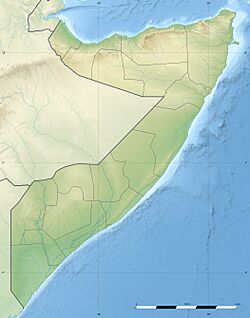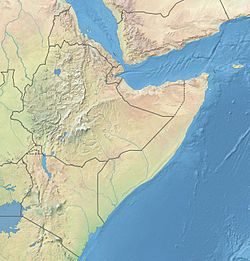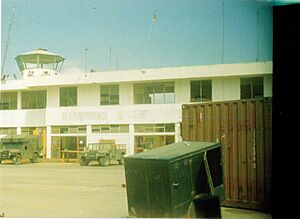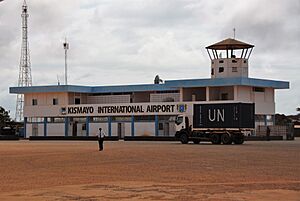Kismayo facts for kids
Quick facts for kids
Kismayo
Kismaayo
كيسمايو Kisimayo Chisimaio
|
|
|---|---|
|
City
|
|
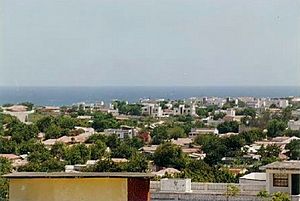
Overview of Kismayo
|
|
| Country | |
| Regional State | |
| Region | Lower Juba |
| District | Kismayo |
| Area | |
| • City | 22.5 km2 (8.7 sq mi) |
| Population
(2014)
|
|
| • City | 1,234,852 |
| • Urban | 1,458,000 |
| Time zone | UTC+3 (EAT) |
Kismayo (also spelled Kismaayo) is an important port city in southern Somalia. It is the main business center of the Jubaland region, which governs itself.
The city is located about 528 kilometers (328 miles) southwest of Mogadishu, Somalia's capital. It sits near where the Jubba River meets the Indian Ocean. In 2005, Kismayo had a population of around 89,333 people.
Contents
History of Kismayo
Ancient Times
Long ago, Kismayo was part of a group of Somali city-states. These cities were busy trading centers. Somali merchants traded with places like Ancient Egypt, Greece, and the Roman Empire. They used special ancient boats called beden to carry their goods across the sea.
Middle Ages and Early Modern Period
Kismayo started as a small fishing village. During the Middle Ages, the powerful Ajuran Sultanate ruled this area. They used the Jubba River for their farms.
After the Ajuran Sultanate ended, the Geledi Sultanate took control. This kingdom became very strong under leaders like Sultan Yusuf Mahamud Ibrahim and Sultan Ahmed Yusuf. They even made powerful empires like the Omani Empire pay them tribute.
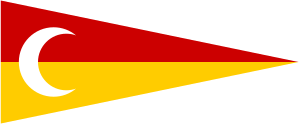
Colonial Era
When Italy took control, they called the city Chisimaio. Kismayo and the northern part of the Jubaland region became part of Italian Somaliland in 1926. Britain kept control of the southern part, which was later called the Northern Frontier District.
Kismayo During the Somali Civil War
After Somalia's central government fell in 1991, different groups fought for control of Kismayo. The United Nations sent peacekeepers to the city in 1993 to help keep order. However, fighting continued, and the last UN troops left in 1994.
Over the years, various groups controlled Kismayo. In 2006, a group called the Islamic Courts Union (ICU) took over much of the city and southern Somalia. They introduced Shari'a law. The Somali government, with help from Ethiopia and the African Union, fought back and regained control.
Later, a more extreme group called Al-Shabaab emerged from the ICU. They took control of Kismayo and other towns. In 2012, the Somali National Army and AMISOM (African Union Mission in Somalia) troops successfully recaptured Kismayo from Al-Shabaab. This was a big step towards bringing peace back to the city.
In 2013, a new local government called the Juba Interim Administration was set up and recognized. In 2019, an attack happened at a hotel in the city, causing many deaths.
Geography and Climate
Where Kismayo is Located
Kismayo is in the fertile Juba Valley in southeastern Somalia. It is right on the coast of the Somali Sea. Some nearby towns include Xamareyso to the northeast and Qandal to the south. The largest cities close to Kismayo are Jamaame, Jilib, and Merca.
 |
Qeyla Dheere | Dalxiiska | Xamareyso |  |
| Saamogia | Indian Ocean | |||
| Iach Bulle | Qandal |
Kismayo's Climate
Kismayo has a hot arid climate, meaning it's very hot and dry, even though it gets some rain. The weather is hot all year. There are seasonal winds called monsoons and sometimes droughts. The main rainy season, called gu, happens from April to July. This brings fresh water and helps plants grow.
| Climate data for Kismayo | |||||||||||||
|---|---|---|---|---|---|---|---|---|---|---|---|---|---|
| Month | Jan | Feb | Mar | Apr | May | Jun | Jul | Aug | Sep | Oct | Nov | Dec | Year |
| Record high °C (°F) | 31.8 (89.2) |
33.1 (91.6) |
34.0 (93.2) |
37.8 (100.0) |
34.0 (93.2) |
34.0 (93.2) |
32.3 (90.1) |
32.4 (90.3) |
30.3 (86.5) |
31.5 (88.7) |
32.2 (90.0) |
33.0 (91.4) |
37.8 (100.0) |
| Mean daily maximum °C (°F) | 29.6 (85.3) |
29.9 (85.8) |
31.0 (87.8) |
31.8 (89.2) |
30.4 (86.7) |
28.6 (83.5) |
28.0 (82.4) |
28.3 (82.9) |
28.6 (83.5) |
29.5 (85.1) |
30.5 (86.9) |
30.5 (86.9) |
29.7 (85.5) |
| Daily mean °C (°F) | 27.1 (80.8) |
27.3 (81.1) |
28.2 (82.8) |
28.6 (83.5) |
27.3 (81.1) |
26.1 (79.0) |
25.6 (78.1) |
25.7 (78.3) |
26.0 (78.8) |
26.8 (80.2) |
27.5 (81.5) |
27.5 (81.5) |
27.0 (80.6) |
| Mean daily minimum °C (°F) | 24.2 (75.6) |
24.5 (76.1) |
25.4 (77.7) |
25.8 (78.4) |
24.8 (76.6) |
23.5 (74.3) |
23.1 (73.6) |
23.3 (73.9) |
23.3 (73.9) |
24.0 (75.2) |
24.5 (76.1) |
24.4 (75.9) |
24.2 (75.6) |
| Record low °C (°F) | 21.0 (69.8) |
22.0 (71.6) |
23.0 (73.4) |
21.3 (70.3) |
20.0 (68.0) |
21.0 (69.8) |
19.0 (66.2) |
21.0 (69.8) |
22.0 (71.6) |
22.4 (72.3) |
22.5 (72.5) |
22.0 (71.6) |
19.0 (66.2) |
| Average rainfall mm (inches) | 1 (0.0) |
1 (0.0) |
3 (0.1) |
39 (1.5) |
111 (4.4) |
89 (3.5) |
52 (2.0) |
21 (0.8) |
21 (0.8) |
15 (0.6) |
17 (0.7) |
3 (0.1) |
374 (14.7) |
| Average rainy days (≥ 0.1 mm) | 0 | 0 | 0 | 4 | 7 | 11 | 9 | 5 | 3 | 2 | 2 | 1 | 43 |
| Average relative humidity (%) | 77 | 76 | 76 | 77 | 80 | 80 | 80 | 79 | 78 | 78 | 77 | 77 | 78 |
| Mean monthly sunshine hours | 235.6 | 226.0 | 248.0 | 210.0 | 257.3 | 207.0 | 192.2 | 251.1 | 225.0 | 248.0 | 225.0 | 217.0 | 2,742.2 |
| Mean daily sunshine hours | 7.6 | 8.0 | 8.0 | 7.0 | 8.3 | 6.9 | 6.2 | 8.1 | 7.5 | 8.0 | 7.5 | 7.0 | 7.5 |
| Percent possible sunshine | 64 | 73 | 69 | 62 | 59 | 57 | 56 | 62 | 64 | 66 | 66 | 66 | 64 |
| Source 1: Deutscher Wetterdienst | |||||||||||||
| Source 2: Food and Agriculture Organization: Somalia Water and Land Management (percent sunshine) | |||||||||||||
Education in Kismayo
Kismayo has a university called Kismayo University (KU). It was started in 2005 and is located just north of the city.
Economy of Kismayo
Kismayo's economy relies on trade and local goods. In 2008, a day's work paid about $4.50. The price of red rice was about $1.31 per kilogram, and a liter of diesel cost about $1.23. A camel could cost over $435. The city produced about 780 metric tons of cereal in 2008.
Transportation in Kismayo
Kismayo Airport
Kismayo has an airport about 10 kilometers (6 miles) from the city. It used to be a training base for the Somali Air Force. The airport was damaged during the civil war but was reopened in 2008 after being repaired. It was also renamed after Imam Ahmed Gurey, a Somali military leader from the 1500s.
In 2013, the Juba Interim Administration took over the airport's management. The money earned from the airport helps pay for services and security in Jubaland.
Roads Connecting Kismayo
Three main roads connect Kismayo to other important areas in Somalia:
- Highway 3: This 600-kilometer (373-mile) road runs through the Juba Valley, connecting Kismayo to towns like Beled Hawo and Bardera.
- Mogadishu Freeway: A paved 528-kilometer (328-mile) highway links Kismayo directly to the capital city, Mogadishu.
- Northwest Highway: This road goes northwest from Kismayo to Afmadow and then to Dhobley.
In 2015, the local government started a project to clean and improve Kismayo's roads. This included clearing blocked streets and developing the city's road network.
Kismayo Seaport
Kismayo has a large port located on a small piece of land that sticks out into the Somali Sea. This land was once a small island but was connected to the mainland by a narrow road when the modern Port of Kismayo was built in 1964. The United States helped build it.
The port was used by the Somali Navy and, for a time, by the Soviet Navy. In 1984, Somalia and the United States worked together to fix up the port because it had become worn out.
The Port of Kismayo also came under the control of the Juba Interim Administration in 2013. Like the airport, the money and resources from the seaport are used to improve services and security in the Jubaland region.
Notable People from Kismayo
- Mohammed Sagaf: A footballer who plays for the Tanzania national football team.
- Mohamed Ibrahim Liqliiqato: A military and political leader who served as an ambassador and Speaker of Parliament.
- Abdullahi Ahmed Irro: A general in the Somali National Army.
- Hussein Samatar: A politician, banker, and community organizer.
Images for kids
See also
 In Spanish: Kismaayo para niños
In Spanish: Kismaayo para niños


